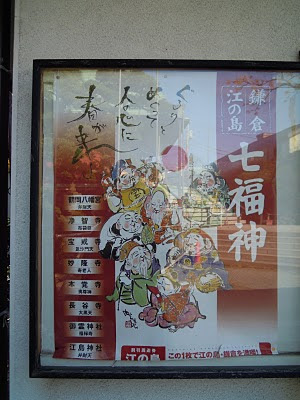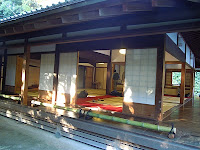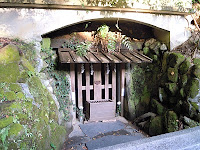 I spent four days and a half with an American tourist, Mr. Bruce Lieber. He came to Japan on purpose which I will explain later and I have his permission to write about his trip on my blog and call him Bruce.
I spent four days and a half with an American tourist, Mr. Bruce Lieber. He came to Japan on purpose which I will explain later and I have his permission to write about his trip on my blog and call him Bruce.Dec.17,2010(Fri) is the first day for me to take care of him. We went to three buildings nicknamed King(Kanagawa Municipal Hall), Queen(Yokohama Customs Office) and Jack which are all in the Kannai area.This picture was taken in the Yokohama Port Opening Memorial Museum aka Jack.
Then we walked through Yamashita park and had lunch on the first floor of Marine Tower. After lunch we saw the monuments of James Curtis Hepburn and Eliza R. Scidmore and went up to America-yama Park by elevator. We saw Yokohama Foreign General Cemetary, Harbor View Park and walked down to China Town. We looked into a mausoleum 'Kantei-byo' which is a Chinese shrine. A Chinese war lord around 160 AD was apotheosized and most of the China towns have Kantei-byo. When we went out its gate, we saw Joseph Heco's monument. He was the first Japanese American who worked for the American consulate in Yokohama. We looked for a souvenir shop of Yokohama Baystars and finally found one in front of Kannai station.We walked in Yokohama all day, so I thought Bruce was tired a little bit. But he said there was no problem. He went to Okinawa the next day and spent four days there with a British journalist.It was his
 main purpose to go to Koza,Okinawa. If you read the Ryukyu Shimpo dated Dec.20,2010(Mon), you already knew of him. That day was the 40th anniversary of the Koza Riot.
main purpose to go to Koza,Okinawa. If you read the Ryukyu Shimpo dated Dec.20,2010(Mon), you already knew of him. That day was the 40th anniversary of the Koza Riot. I won't write about the Koza Riot here because you will learn it soon in the near future in an article of The Japan Times'.
Bruce came back to Yokohama and went to Kamakura with me. On Dec.22 we visited Kotoku-in Temple, Hase-dera Temple,Zeniarai-benten Shrine, Hokoku-ji Temple and Tsurogaoka-hachimanngu Shrine.Bruce seemed to be impressed by the Great Buddha at Kotoku-in Temple.

The picture below was taken in the precinct of Hase-dera Temple by a kind gentleman spontaneously.


At a noodle restaurant 'Kishimen' we had lunch and the master who can speak English well took this photo.
When we were walking around the crossing of the Hase area, a tall western man and a cool lady asked me how to get to Hase station. I replied ,' Go straight this way. You'll never miss the station.' Then Bruce asked him, 'Where have you come from?' The man replied, 'DC.'
On the way back to his hotel we stopped by Noh theater in Yokohama. We were lucky that we could enter and take a picture.

 On Dec.23 we went to the Imperial Palace to see the celebration of the Emperor's Birthday. It was holy and impressive. There were many foreign tourists. Among them I saw a group of westerners who were taking pictures by themselves. So, I said to a man in the group that I would take the picture of the whole family with his camera. He passed me his camera and then three other women passed us their cameras. Bruce and I took thier pictures with those cameras. In return he took our pictures with my camera and that of Bruce.
On Dec.23 we went to the Imperial Palace to see the celebration of the Emperor's Birthday. It was holy and impressive. There were many foreign tourists. Among them I saw a group of westerners who were taking pictures by themselves. So, I said to a man in the group that I would take the picture of the whole family with his camera. He passed me his camera and then three other women passed us their cameras. Bruce and I took thier pictures with those cameras. In return he took our pictures with my camera and that of Bruce. 
Bruce asked them where they came from and then a young girl replied ,'Brisbane, Australia'After this we went to Ginza and Hiroo before we went back to Yokohama.
On Dec.24 we went to Sankei-en Garden which is in the Honmoku area of Yokohama. We took a train of the JR Negishi line at Kannai station and got off at Negishi station.Then we took a bus and got off at Honmoku bus stop. It took only five minutes from the bus stop to the garden.
 Sankei-en was a co-product of an entrepreneur and his adopted son.
Sankei-en was a co-product of an entrepreneur and his adopted son.Zenzaburo Hara founded his raw silk trading company in the Kannai area.
He was one of the most successful merchant in Yokohama from the end of the Edo to the early Meiji era. His granddaughter Yasu got married to a man who was a teacher of her high school. Zenzaburo adopted the man as his son.The man's name was Tomitaro Aoki. Aoki was his prenuptial name.
Zenzaburo who lived in a big house in the Nogeyama area bought the vast land here in Minotani which literally means three valleys.
 Tomitaro Hara succeeded his adoptive father's business. He made use of the wealth and bought old buildings of temples and shrines. He dismantled them, brought them here and reconstructed them here. He was a haiku poet and enjoyed a tea-ceremony with his pseudonym Sankei which means three valleys. This garden was named after his psedonym.
Tomitaro Hara succeeded his adoptive father's business. He made use of the wealth and bought old buildings of temples and shrines. He dismantled them, brought them here and reconstructed them here. He was a haiku poet and enjoyed a tea-ceremony with his pseudonym Sankei which means three valleys. This garden was named after his psedonym. After World War ⅡHara family abandoned to restore the garden and donated it to Yokohama city.
After World War ⅡHara family abandoned to restore the garden and donated it to Yokohama city.Yokohama city established Sankei-en Preservation Organization and repaired it with Yokohama citizens' tax. So, Yokohama citizens who are 65 years old and over are free of charge.I am one of them who can enter the garden for nothing.The organization collected some more buildings. Among them is a big farm house which was brought here from Shirakawa-go in Gifu Pref. which is one of the 14 world heritage sites of Japan. I like the farming house because I can enjoy the atmosphere of Shirakawa-go without going to Gifu.After enjoying the beautiful garden we went to a British pub near Sakuragicho station and had lunch. I ate fish and chips for the first time in my life. They were delicious! Then we went up to the observatory of the Landmark Tower. Bruce shouted 'Wow!'
On Dec.25 I saw Bruce off to YCAT at 12:30 pm.
I had a nice experience. Through this tour I learned a lot of things which I didn't know. Thank you, Bruce!









































